CNPS 2017 a Success!
It’s hard not to be a success in such a beautiful setting: Vancouver Canada in the summer! Many conference goers toured this beautiful city and the nature around it with towering pines, beautiful mountains, and cliffs about a blue and green sea. The conference itself was held at the beautiful University of British Columbia campus in the Ponderosa building built in 2016.
(Conference photos by Hans Strupat, CNPS member and photographer, other photos by David de Hilster)
Conference Opens Up
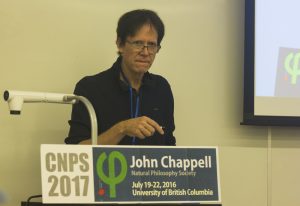
CNPS President David de Hilster making opening remarks at CNPS 2017.
The opening talk by CNPS President David de Hilster included an introduction written by Dr. Peter Marquardt. Both talked about the history of the group and the importance of keeping this group and movement alive. Here is Peter’s text read by David de Hilster:
Dear friends and fellow science lovers,
Tempora Mutantur – Mutamur In Illis. This good old Latin “times change – we change with them” is a handy starter for many a discussion. Everybody can tell about changes from their own experience. You, the participants of this meeting, can also tell from the story of our dissident family.
Humans change, so do their societies, living conditions, technologies, politics, and last not least also their sciences. We live in the age of globalization and digitalization that has confronted us with unprecedented conditions. What next? We have somehow to cope with these “revolutions” that became the symbol of “change”. Changes occur faster and its hard to accommodate with them. You meet because you rightfully feel that something has not changed in science, in physics in particular: It is the over-loud voice of mainstreamers who seem to have locked the door of their ivory tower to the tax-paying public and to their colleagues who dare to lift a critical finger. But this ivory tower is not the place where the real physics is. Scientists are in a better position than, say, philosophers. In science, opinions don’t count – they must not. That should put an end to fruitless discussions. One of the fatal opinions is: “Math gives us the correct result, so the theory is correct.” It can’t be told too often and too boldly that a “correct” result is only necessary but by no means sufficient to prove a theory right. It is understandable that mainstreamers don’t like this, but the main public should enjoy it as a surprise not offered by textbooks and university lectures. So, let’s go on asking nasty questions like “Why does the formula work while the physics tells us a different story?” It should be easy to tell friendly math from fatal math. Just think of the historically most prominent example, Ptolemy vs Aristarchos (and some 18(!) centuries later Copernicus, Galilei, Kepler). In the beginnings of the heliocentric world view (before elliptic orbits were considered), the geocentric model was at least as precise – a drastic example for mighty, mighty math not caring for physics. The situation, alas, has not changed until now. Physics needs whistle blowers more than ever.
You meet again to exchange ideas in the tradition of the old Natural Philosophical Alliance.
In view of the deplorable development of establishment physics, the foundation of NPA in 1994 and its lucky continuation as CNPS is a necessity. Ever since I joined the conferences I enjoyed the friendly atmosphere and shared with you the joy of being a non-mainstreamer.Among the members of our dissidents’ family there are authors of great textbooks which deserve worldwide attention. Keep up the good work! And in doing so, please remember three friendly and helpful assistants of natural science: Modesty, honesty, and courage. They should be our steady companions. Modesty should be our reminder that Nature stays to be our master, no matter how much of what we call “progress” we will make. Honesty is a duty against ourselves and others because doing science seriously is a continuing process of rethinking, questioning, correcting, and, as Karl Popper put it, falsification. Courage is on our flag because we stand for a minority that does not subdue to non-scientific aims like striving for careers under the fatal motto “publish or perish”. One more ingredient that lacks so sadly on the mainstreamers’ side is particularly important to me: Humor. What’s going on in mainstream physics cannot be handled without a certain taste of irony. We should have a distant view of all the cults that make “them“ feel so self-confident and resistant against criticism. Scientists must take seriously what they do, but it’s worth a try to keep personal peculiarities and emotions out of the business.
The ongoing process of scientific efforts may require to retreat for a better jump forward (il faut reculer pour mieux sauter as the French say). This caused me since 2011 to get a distant view of physics – and of myself, too. Tempora Mutantur…
Our dissidents’ family lost so many dear members in the course of time. Treasuring their memory obliges us to stay together as a group of scientists where everybody feels at home who welcomes the benefits of independent thought.
I wish you a fruitful, peaceful, friendly, and enjoyable conference in the spirit of the ones I am so happy to remember!
Enjoy the eclipse on Aug. 21 as I will do from a distance via internet!
Greetings from far away Germany, Peter Marquardt. (Cologne)
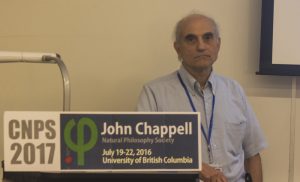
Bruce Nappi presents his findings after hundreds of hours of analysis on CNPS email chains.
Report on Member Email Streams and Organization
Next was a presentation by Bruce Nappi on an in depth analysis of emails chains, topics, and how many hours CNPS members spend on chains. The shocking number: in 2016 over 17,000 hours spent on email chains. How do we use some of this manpower to help the CNPS grow and prosper? You can read Bruce’s analysis in depth in the proceedings.
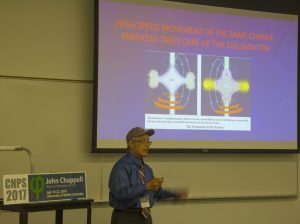
Cameron Wong presents his interpretations of the cosmos
Cosmology Dominates the First Day
Two of the most prolific CNPS members, Cameron Wong and Dr. Ray Gallucci gave talks on cosmology including the formation of the solar system, quasars, sun spots, dark matter, and varying light speed. Cameron presented very detailed works on possible explanations for much of the mysterious cosmos while Ray examined in a very engineering way, his careful analysis for another explanation for dark matter.
In the evening, there was a spirited discussion between attendees about models and terminology.

Dr. Ray Gallucci presents one of his five papers being one of the most prolific CNPS members in recent years.
CNPS Second Day – Aether
The second day was filled with many papers on aether. A clear majority of CNPS members at the conference subscribed to some form of aether. Ray Gallucci presented twice, the first paper on muons and if they really confirmed time dilation as proposed in special relativity. The second was later in the day where Ray pondered the existance of aether. Although Ray is on the fence about the aether theory, he always does a thorough analysis of other’s works which is invaluable to the group. Given he does not have his own theory, Ray’s work consists of thorough examiniation and calculations of other’s theories, models, and claims and the result of Ray’s research helps everyone.
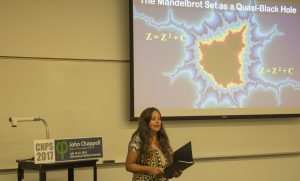
Lori Gardi showing visual evidence for her fractal model of the cosmos and how her generated fractals mimic much of what we see in the skys at night.
New member Lori Gardi presented in the morning and was on the fence about participating in person in the conference. Afterwards, she said she was really glad she attended. A very meticulous scientist, she presented her paper “The Mandelbrot Set as a Quasi-Black Hole” and talked about how fractals are possibly related to black holes and the entire universe. She also kicked off the day filled with aether papers and presented a paper on a case for a medium for light and how to possibly detect it.
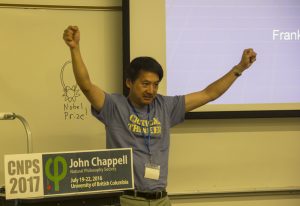
Franklin gave an animated talk about aether, finding the aether particle, and winning the Nobel Prize.
Franklin Hu who runs the Saturday morning Video chats and discussions also entered his take on aether models no only talking about his particular model for aether, but also pitching the fact that the group should come together and try to show proof for the existence of an aether particle claiming that doing such, would merit a Nobel Prize. Franklin’s enthusiasm was evident by his presentation which was anything but dry!
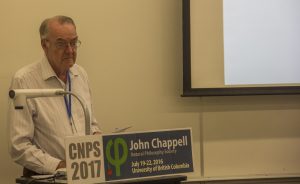
Duncan Shaw, Vancouver native presented his model for aether dubbed by de Hilster as the “Vancouver School” of aether models.
Duncan Shaw didn’t have to travel very far to this year’s conference. He was a sort of surrogate host for the conference with Vancouver Canada being his home. Duncan presented a model of inflowing aether that broke down into its parts, leaving a body, and returning once again after condensing. Inspired by the weather in Vancouver, David de Hilster dubbed Duncan’s aether theory the “Vancouver School” of aether which seemed quite appropriate.
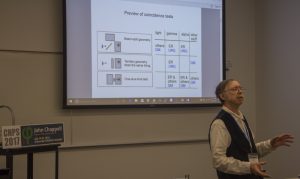
Eric Reiter talks about how a threshold model for quantum mechanical experiments perfectly describes the data without the mumbo-jumbo of quantum mechanics duality and spookiness.
To round out the day was a great paper and talk by Eric Reiter on as he calls it, the wave-particle duality entanglement nonsense. It was very interesting to see the detail at to which Eric examined and analyzed quantum mechanics experiments to show how a threshold model can easily describe beam splitting experiments giving us the ability to throw out the entire non-sense of quantum mechanics duality and spookiness.
Social Evening of Stimulating Discussion
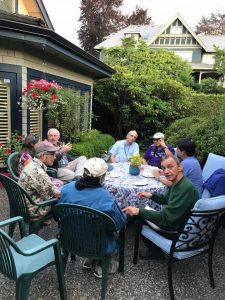
CNPS members talk amongst themselves on a very comfortable evening at the residence of Duncan Shaw in beautiful Vancouver Canada.
After a day of aether talk, a social evening of great wine, great friends, and great conversation was had at Duncan Shaw’s residence which was only a few kilometers from the campus.
Members broke up into groups, talking in pairs, and bigger groups on subjects ranging from aether, particles, experiments, and even human consciousness.
Day Three – Other Models, Math, and Expansion Tectonics
Day three was full of many broad subjects with new models of the universe being presented or used to explain natural phenomena. It was also the day for the keynote speaker at the event, Dr. James Maxlow to present the John Chappell Memorial talk to the group.
First off was Bruce Nappi with his Space-Latice theory where he showed us a fascinating old video of all things: bubbles in beer. The bubbles set up a lattice in which spaces traversed the lattice when a force was applied. Bruce’s theory certainly challenged everyone to think outside the box which is one of the great things about the CNPS members and the conferences.
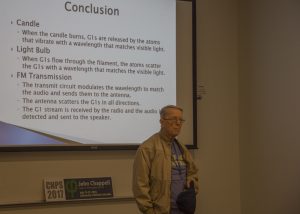
Bob de Hilster applies the particle model to the candle, the light bulb, and FM transmission.
Next up was Bob de Hilster with an unlikely talk on “The Candle, the Lightbulb, and the Radio” using the Particle Model he and his son David are working on. His explanation of why we see the colors in a flame was embraced by Duncan Shaw who saw such an explanation can be used in aether theory. Bob politely answered “your welcome” and noted that aetherists will have a “harder time” with explanations.
Next was son David who guaranteed that he would get people angry and he certainly did. David presented two papers – one comparing the particle model with aether, and the other comparing models in general. Where David got the most emotional response is when he talked about his concern that the aetherists in the CNPS were becoming an intimidation group and becoming a “faction” in the group that makes others in the group feel left out. Of course, there ensued some spirited discussion.
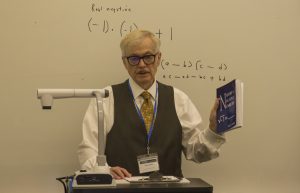
Peter Erickson talked pure mathematics and about one of his favorite subjects: the square root of negative one.
One of the older members of the CNPS (before called the NPA) who it was great to see once again presented a talk on the square root of negative one. Peter Erickson presented his work from his latest book on the square root of negative one pointing out the limitations of the real number system we use and saying we can always shift the access to avoid the square root of negative one or negative numbers all together. David de Hilster who is also a mathematician said the talk blew his mind at least 6 times. A spirited exchange ensued with one of the CNPS members as passions are quite high as always at these conferences. After all, everyone attending are extremely passionate about their work.
Expansion Tectonics
The highlight of the day was of course the topic of expansion tectonics and there were two presentations on that subject by two close friends: John Eichler, and Dr. James Maxlow.
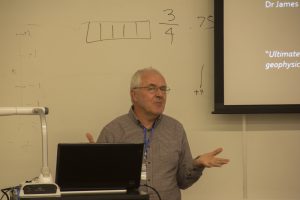
Dr. James Maxlow giving the annual John Chappell Memorial Talk on Expansion Tectonics.
John Eichler presented to the group via Video conference on a new mechanism for mass increase inside the earth: cold fusion. John cited several experiments showing that cold fusion can in fact generate elements and be possibly responsible for mass increase as evidenced by expansion tectonics geologists such as Dr. James Maxlow. It was the first time James Maxlow had seen this presentation and idea from John and it will be interesting to see their future interactions with this.
Soon after John spoke, Dr. James Maxlow gave the John Chappell Memorial Talk on expansion tectonics presenting an extremely large and impressive set of data that supports the expanding radius and mass of the earth over billions of years. Plots of flora and fauna were laid out to help locate the shallow seas on a smaller diameter earth. Equations and graphs were presented along with models of the earth showing expansion and the geology of the land during expansion. It is quite impressive that Dr. Maxlow has even gone to describe the earth all the way back to its molten state using the geology on top of the continental plates to further reconstruct expansion before the break up of the continental plates. Amazing!
Lifetime Achievement Award
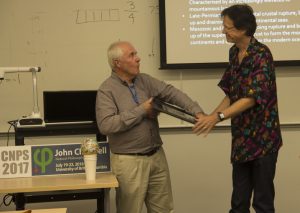
David presents Dr. James Maxlow with the lifetime achievement award for his work with expansion tectonics.
After the talk, James was presented the John Chappell Natural Philosophy Society’s Lifetime achievement award for his work on expansion tectonics. This is a very prestigious award and company of people to be a part of and James accepted it with great humility and some humor!
In turn, Dr. Maxlow gave David a model he made of the earth’s geology. David is a student of Dr. Maxlow’s work as are most all of the CNPS members.
After the talk, everyone went out to our celebration dinner which was part of the official CNPS Friday activities.
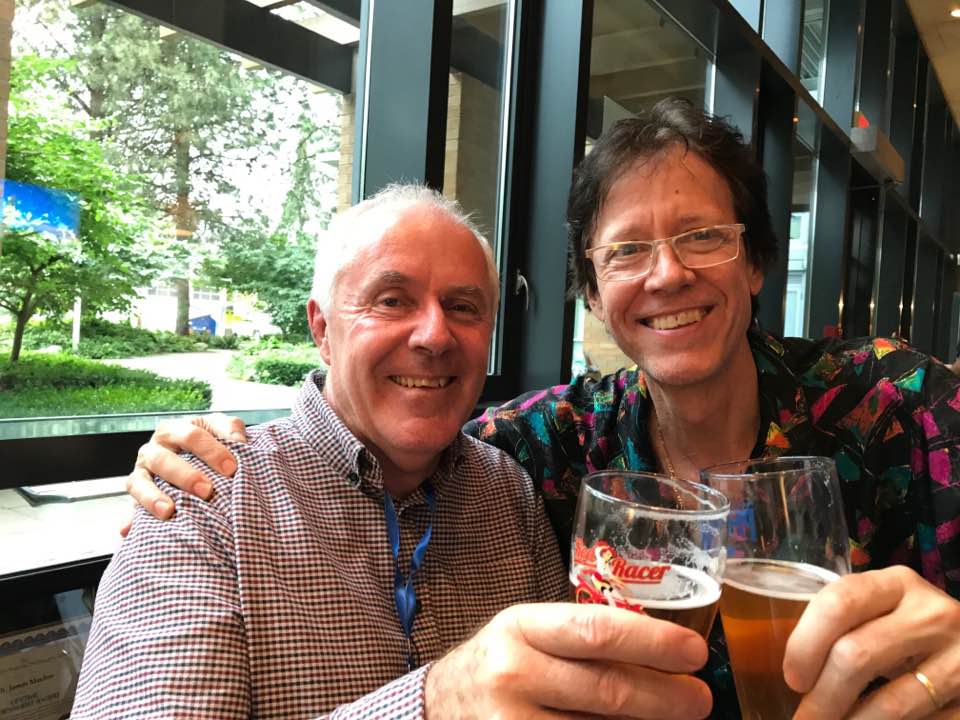
They finally meet in person: David de Hilster, a student and great admirer of Dr. James Maxlow poses for a photo during the honorary dinner at the UBC campus in Canada.
Saturday Presentations
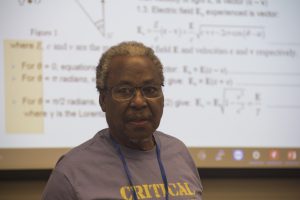
Musa Abdullahi presented two papers on Saturday morning that generated some stimulating discussions.
There was no drop off in quality or importance as the CNPS members went into Saturday.
Bob de Hilster presented a paper for an absentee member on aether. Although Bob de Hilster has his own particle model, he agreed to present this member’s work in absentia which was for a paper of over 30 pages in this year’s proceedings. Bob did admirably well given he is not an aetherist himself.
Musa Abdullahi who came all the way from Nigeria, presented two papers to CNPS members: one on aether, and another on a proposed experiment to disprove special relativity. The first paper was on an experiment to show special relativity wrong by looking at the path of a charged particle in a field. The second paper presented an aether theory that would describe light and gravitation with one model.
Dr. Alexander Unzicker
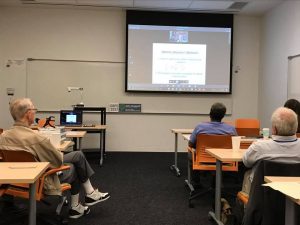
Dr. Alexander Unzicker, author of “The Higgs Fake”, and “Einstein’s Lost Keys” talks about simplicity in physics of which, particle physics has almost none.
One of the big hits to CNPS 2016 in Maryland was the video conference with Dr. Alexander Unzicker, author of “The Higgs Fake”, and “Einstein’s Lost Keys”. He did not dissapoint in 2017 with a very stimulating talk on simplicity in science. He explained that with each paradigm shift in science, there should be a simplification and showed this throughout history. He also had some great advice for those working outside the mainstream: work alone and go forward. He said that you will not necessarily find help from other dissidents and certainly not from mainstream science so it is best to put your head down, and go tenaciously forward with your own work.
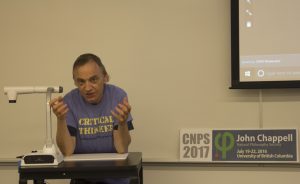
George Coyne speaking on the mind and consicousness to the CNPS group, wrapping up a great CNPS 2017!
The last talk was a surprise talk on the brain and consciousness by George Coyne. This was a very interesting talk especially to those who are computer programmers and who like discussions of what is consciousness, the brain, thought, and the like. George has a book out on the subject.
Final Thoughts and Sightseeing
Some members stayed around for a day or two to do some site seeing. CNPS President David de Hilster took lifetime award recipient Dr. James Maxlow to see the sites. They were accompanied by Bob de Hilster and Lori Gardi. They took a cable car up the Vancouver mountains and saw some spectacular sites.
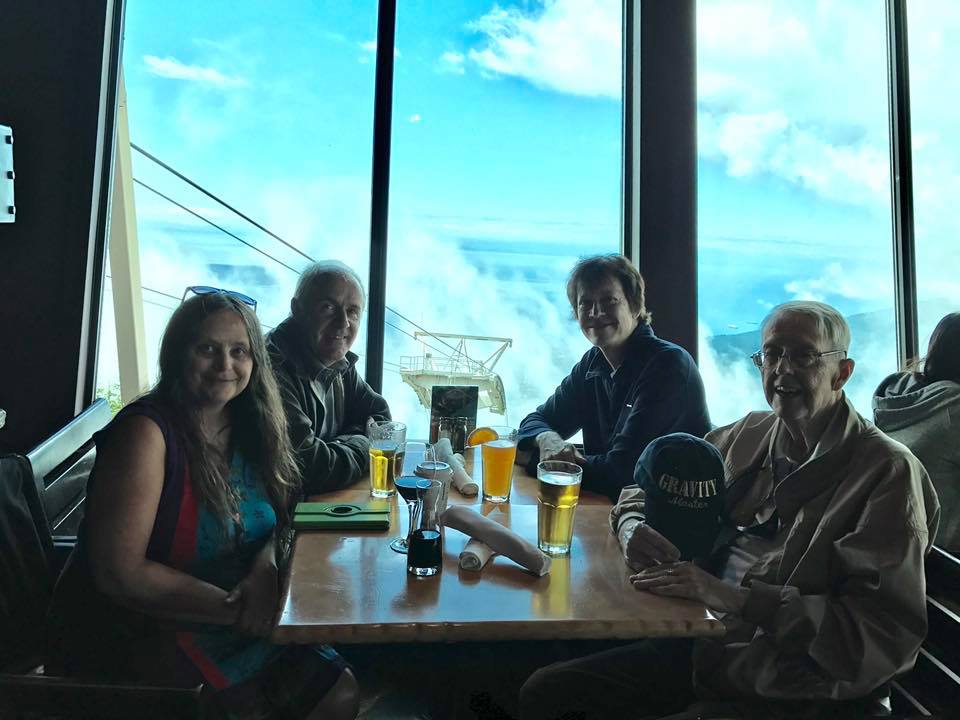
Lori Gardi, James Maxlow, David de Hilster, and Bob de Hilster pose way above the clouds and city of Vancouver Canada on a day of sightseeing before returning home.
The conference will be forever burned into the memories of the members who attended for the ideas presented, the spirited discussions that were had, but most of all, by the growth of each person who attended. The number one thing heard during the conference was the wonderful ability to turn or walk up to someone to start a conversation on something that was of interest to both parties. The personal interactions you get when attending face-to-face conferences is really impossible to reproduce online (although Bruce Nappi may have something to say about that).
Each person who attends goes away with new ideas, new insights, and new collaborations – something that only attending these conferences will afford. Some of the best conversations come during lunch, during walks, and during drives to site see.
Plans for 2018
Right now, we are looking to return to the East Coast for CNPS 2018. We will have an answer sometime in August of 2018 as to where giving people plenty of time so that they can attend.
Thanks to EVERYONE who made CNPS 2017 a memorable event! It certainly was held in one of the most beautiful and friendly cities on the planet!
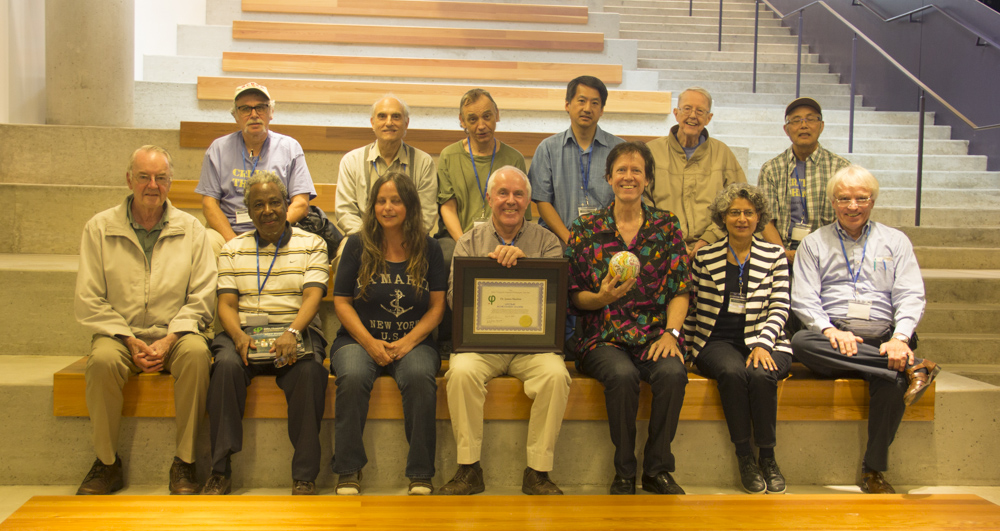
Between talks, some of the CNPS members who attended CNPS 2017 pose on the steps in the new and modern Ponderosa Commons on the beautiful campus of the University of British Columbia Vancouver.
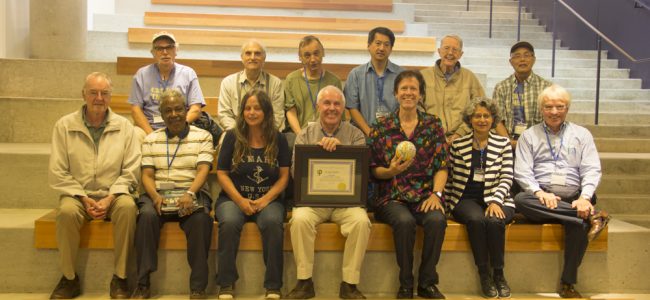

I was struck by Unzicker’s advice that dissidents should not expect help from other dissidents. This has been my experience regarding the paper I published in NPA Proceedings Vol. 9. I too have not responded constructively to other published papers. Part of a dissident’s motivation is to be the one who comes up with an innovative, acceptable revision of the current paradigm. It’s a lonely world out here.
CNPS was a success, but the greatest success remains to be done. I agree with Unzicker and James Decandole that there is a great problem with CNPS in the fact the members do not cooperate. ‘It’s a lonely world out there.’ I have described the same opinion in a blog post: ‘Dialog or monologs.’ There is no use writing papers if they are not discussed. In my opinion written comments are better than phone conferences, since you must not be perfect in English. The comments on these pages are not only few, they are also of bad quality. Instead of commenting the intended paper comments are often used for advocating own pet theory.
We have a good data base and advanced home page and blog possibility and ‘forum’. However, we are not using it properly and that is the reason we have not done the real GREAT success.
Regards ___________ John-Erik
The above comments are one reason why I focus more on examining the theories put forth by others, both within and outside the JCNPS (the other reason is that I’m not as clever as they are in formulating my own) to assess their plausibility. I currently have paper(s) on the JCNPS forum examining the expanding earth/expansion tectonics theory, primarily based on James Maxlow’s work but from a non-geological perspective. I also recently examined Duncan Shaw’s aether theory, as he presented at the 2017 conference and earlier in Physics Essays, which I plan to publish at a future date either in Physics Essays and/or at a JCNPS conference (I have a large backlog of “older” papers yet to publish, including one on former NPA member Steven Rado’s aethro-kinematics, at least one aspect of it). I have also attempted to consolidate others’ theories, in particular JCNPS member Curt Renshaw’s “spring-theory” of light with fellow member Dick Calkins’ light theory, “the medium is the message.” So it is possible to consolidate multiple theories rather than view each as a standalone. As cited in the above comments, perhaps more along this line of effort would be beneficial.
Ray
I would like to give constructive comments to your ideas.
About tidal asymmetry:
If such an effect existed it would not be observable in tides, since our planet would compensate it by accelerating in the same direction.
About Michelson and Morley’s tests:
You discuss if MMX is proving or disproving SRT. I say it proves nothing at all. In my article ABOLISHING THE LORENTZ FACTOR I have demonstrated no effect in the transverse arm, since mirrors in the cavity define C (not C+V) to be ortogonal to mirrors; and also compensated effect in longitudinal arm since the effect in 2-way light is the same as the contraction of matter. This means no time dilation and doubled matter contraction. The reason is that 2-way transmission of positions information between atoms is also effected.
About stellar aberration:
Stellar aberration is also useless, since a telescope detects wave front orientation, and this orientation is NOT changed by ether wind inside the wave fronts. Stellar aberration is therefore caused by changes in observer motion independent of ether wind.
The GPS system works with transmitters and receivers on two different, but concentric spheres, and therefore the ether wind must have a spherical symmetry. A system based on 1-way light speed can tell us about the ether wind.
Regards from ___________________ John-Erik
Not sure what effect you are addressing regarding tides, but I believe that any tidal effects on the solid Earth, be they from differential gravitation and/or barycentric rotation, would be more pronounced in water than in land, so the water tides show more displacement than the land tides. MMX has had so many explanations, with and without aether, dragged or stationary, that one can cite this experiment for or against SRT, etc. The one thing it clearly was not was “null.” I do not assume aether for stellar aberration, although I’m sure it can be explained with aether as well. I remain on the fence regarding the existence of aether, other than believing it is necessary if light truly has a limiting speed. Without aether, I do not see why light speed has a limit. The only other medium by which I can visualize it as propagating as a wave is the combined Renshaw-Calkins hypothesis I offered in one of my papers.